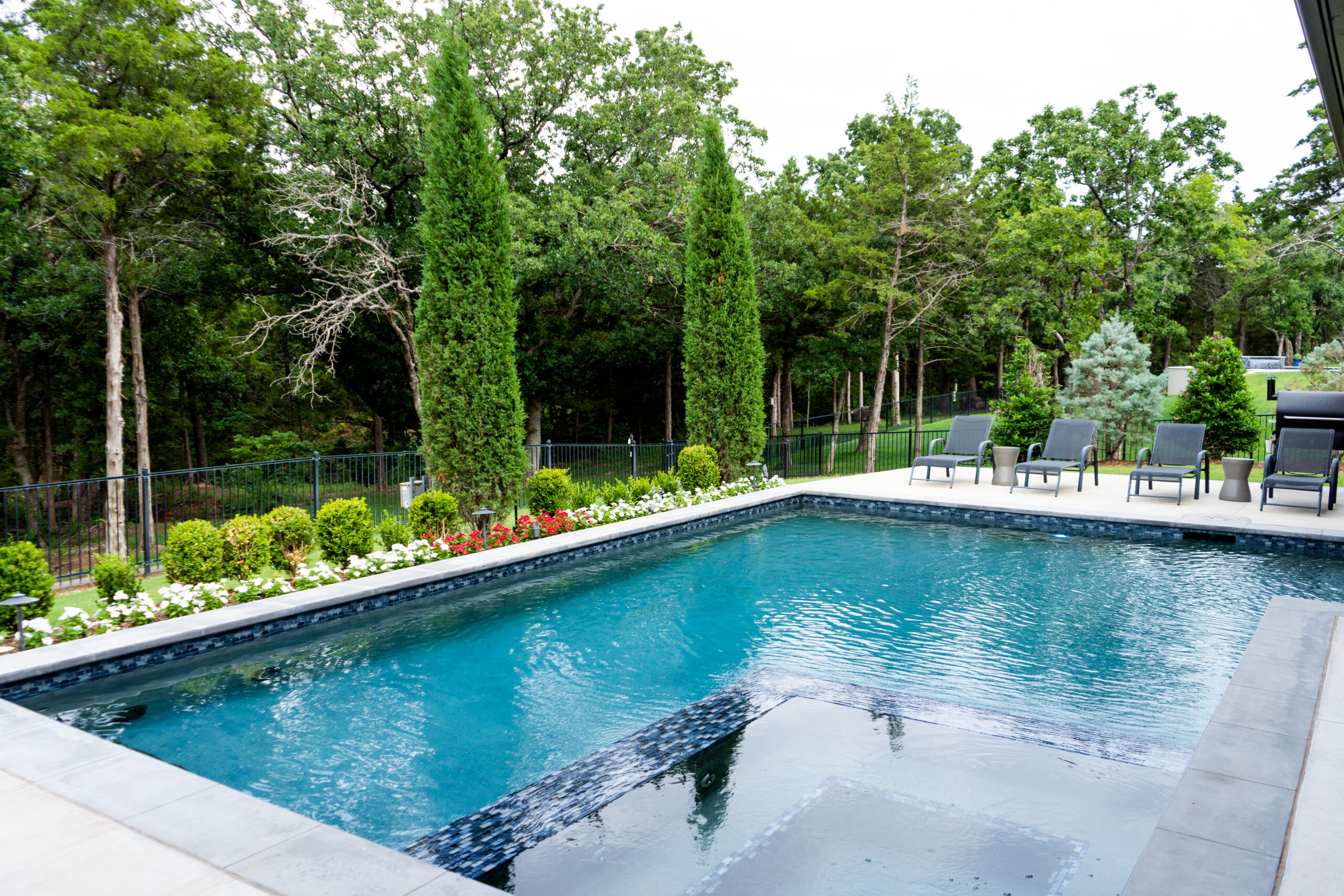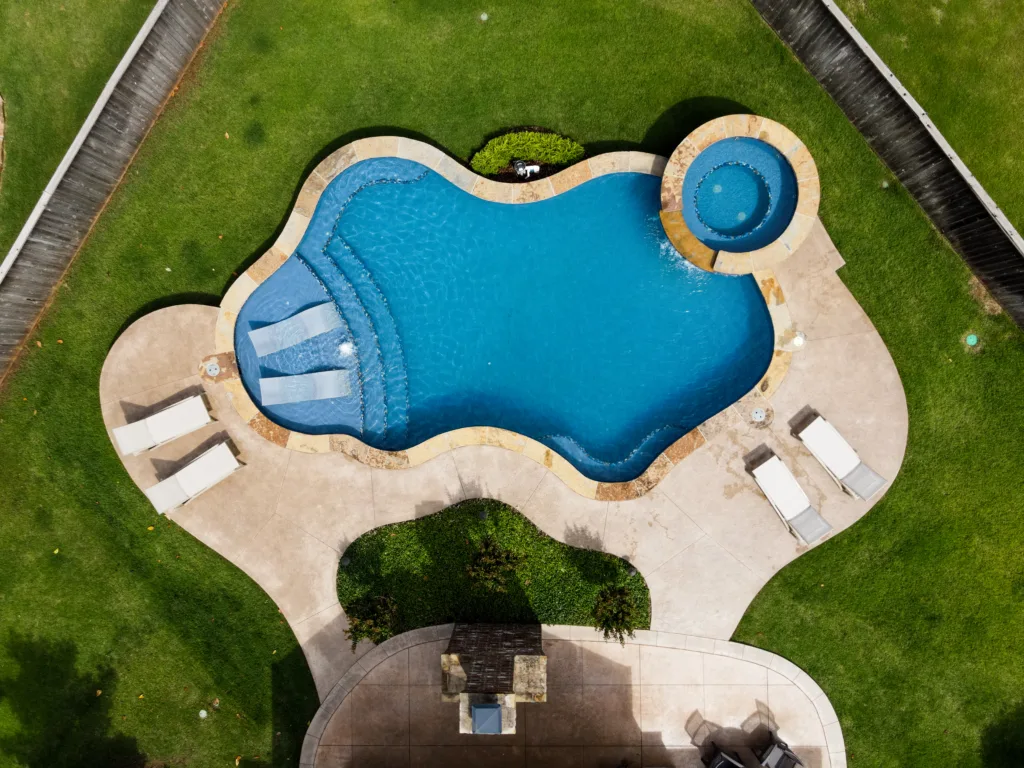What Color Should Pool Water Be?

Deciding the right color for your pool water can be puzzling. Water naturally appears blue due to how it absorbs light, a fact crucial in choosing your pool’s appearance. This blog post will guide you through understanding what influences pool water color and how to select the best shade for upkeep and aesthetics.
Factors That Affect Pool Water Color
Several factors influence the color of pool water, including the presence of algae, mineral content and imbalance, as well as the type of pool finish.
Presence of algae
Algae in pool water is a common issue that can change the color of your swimming pool, signaling poor water health and a need for immediate pool maintenance. These tiny organisms thrive in warm, stagnant water and can turn a clear blue pool into various shades of green, yellow, or even black if left untreated.
Regular pool maintenance tips include keeping chlorine levels balanced to combat algae growth and ensuring proper water circulation through efficient filtration systems.
Testing your pool water regularly helps detect the presence of algae early on. Implementing effective pool water treatment and sanitation methods keeps these unwanted guests at bay, preserving the desired swimming pool water color and ensuring safe swimming conditions.
Mineral content and imbalance
The mineral content of pool water greatly impacts its color and clarity. Imbalances in minerals such as iron can lead to discoloration, causing the water to appear reddish-brown. Additionally, elevated levels of copper can result in a greenish tint.
Maintaining a proper balance of minerals is crucial for achieving the desired pool water color and ensuring optimal health and aesthetics.
Understanding these mineral imbalances and regularly testing the pool water for mineral content is essential for preventing unsightly discoloration and maintaining a visually appealing pool environment.
By carefully monitoring and adjusting the mineral levels, it is possible to achieve crystal-clear, inviting pool water that enhances the overall ambiance of your outdoor space while also ensuring swimmer comfort and safety.
Type of pool finish
When considering the color of pool water, the type of pool finish plays a crucial role. The selection of pool coating indirectly influences the hue and tone of the water. Different finishes such as green, brown, tan, or black pigments will impart specific colors to the pool water based on their background dye.
Understanding this aspect is essential for designing and maintaining pools in line with desired aesthetics and surroundings.
The main determining factor for water color is often overlooked; it’s actually found in the finish of a pool. Different color finishes make different water colors, which is why some finish colors are more popular than others. Check out our water color selector here at ecoFINISH.

Choosing the Right Pool Water Color
Choosing the right pool water color involves considering the pool surroundings and your desired aesthetic. Maintenance and upkeep requirements also play a crucial role in making this decision.
Consider the pool surroundings
When considering the pool surroundings, it’s essential to take into account factors such as natural light, landscaping, and the architectural style of your home. These elements play a crucial role in determining how the color of the pool water will appear.
The reflection of these surroundings onto the water can significantly impact its overall appearance and aesthetic appeal.
The choice of pool finish and its compatibility with the surroundings can have a direct influence on the color of the water. Factors including sunlight exposure, shadows from nearby structures or trees, and even surrounding hardscaping materials all contribute to creating a unique visual effect that affects how the pool water appears.
Adapting to these elements ensures that your pool blends seamlessly with nature’s beauty and complements your outdoor living space.
Understanding these considerations allows for choosing a pool water color that harmonizes with its environment while reflecting your desired aesthetic vision. By integrating these aspects into your decision-making process, you ensure an inviting and visually appealing swimming experience for yourself, family, friends, and guests.
For more information check out our article on what color makes pools look bigger.
Determine your desired aesthetic
Consider your surroundings and your personal preferences when determining the aesthetic you desire for your pool. The color of the pool water will have a significant impact on the overall look of the pool area, so it’s vital to choose a color that complements the pool’s location, landscape, and architecture.
Additionally, consider how different colors may affect the mood or atmosphere around the pool area. By weighing these factors, you can make an informed decision to achieve the perfect visual appeal for your specific setting.
In selecting an appropriate pool water color, it is essential to factor in not only your taste but also practical aspects such as maintenance requirements and water clarity. It’s crucial that you opt for a hue that aligns with both your aesthetic vision and maintenance capabilities – striking a balance between beauty and functionality will ensure long-term satisfaction with your pool design.
Maintenance and upkeep requirements
Maintaining the desired color of pool water requires regular monitoring and adjustments to ensure water balance and quality. Regular testing of pool water chemistry, including pH levels, mineral content, and sanitizer levels, is crucial for maintaining the right color.
Proper filtration and sanitation play a vital role in keeping the pool water clear and free from algae. Additionally, staying on top of maintenance tasks such as cleaning the pool walls, skimming debris from the surface, and ensuring proper circulation are essential for preserving the aesthetic appeal of your pool.
Ensuring effective upkeep involves utilizing appropriate chemicals like chlorine or bromine to keep bacteria at bay while also preventing discoloration or cloudiness. Moreover, maintaining balanced water by adjusting alkalinity and calcium hardness can help sustain optimal color clarity.
It’s imperative to adhere to a consistent maintenance schedule based on manufacturer guidelines for filters, pumps, and other equipment to guarantee efficient functioning. Regular inspection helps identify potential issues early on before they compromise the visual allure of your pool.

Conclusion
Understanding the factors influencing pool water color can help in making informed choices when designing or maintaining a pool. Consider the pool surroundings and your desired aesthetic to determine the right pool water color. Check out our article on our pick for the best pool color.
The presence of algae, mineral content, and type of pool finish are key factors affecting the color. Take into account maintenance and upkeep requirements for a pristine swimming environment.
FAQs
Your pool water should be a clear, sparkling blue. This indicates healthy pool water that is well-maintained and properly balanced with the right chemicals.
Green pool water usually means there’s algae growth, which can happen when the pool’s maintenance is neglected or the chemical balance is off. Pool sanitation and regular maintenance are key to preventing algae.
Choosing the right color for your inground pool involves considering your personal preference, the available finish color options, and how different colors might affect water appearance under sunlight.
While swimsuit colors don’t directly impact pool cleanliness, bright swimsuits can make clear blue waters appear more vibrant and inviting by contrast.
To maintain your desired swimming pools’ color trends while ensuring healthful conditions: test your water regularly using a reliable testing kit; follow a consistent schedule for adding necessary chemicals; ensure efficient filtration; keep up with routine cleaning tasks including skimming and vacuuming; manage pH levels carefully to prevent unwanted changes in water appearance or quality indicators.
